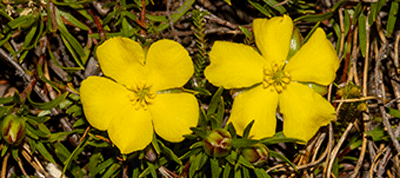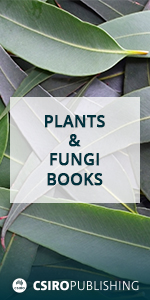Latest
These articles are the latest published in the journal. Australian Systematic Botany is published under a continuous publication model. More information is available on our Continuous Publication page.
SB24016Phylogenomics of Australian sundews (Drosera: Droseraceae)
 , Ed Biffin
, Ed Biffin  , Timothy A. Hammer
, Timothy A. Hammer  , Kor-jent van Dijk
, Kor-jent van Dijk  , John G. Conran
, John G. Conran  and Michelle Waycott
and Michelle Waycott 
Drosera is a diverse group of carnivorous plants that are speciose in Australia and has undergone significant taxonomic revisions. Data presented here were generated as part of the Genomics for Australian Plants initiative. We are the first to use a phylogenomic approach for Drosera and include taxa from all major clades occurring in Australia. Our analyses support the two major groups of Australian Drosera as subgenera but raise uncertainty about the confidence in the species depauperate sister groups. (Photograph by Timothy A. Hammer.)
This article belongs to the collection: Genomics for Australian plants.
SB24016 Abstract | SB24016 Full Text | SB24016PDF (3.4 MB) | SB24016Supplementary Material (197 KB) Open Access Article
SB24027Phylogenetic and biogeographic insights into the reproductive evolution and taxonomy of Australasian Teucrium (Lamiaceae)
Why the cosmopolitan mint family member Teucrium is so morphologically diverse throughout Australasia is unknown. Relationship and divergence times were estimated using genomic data, identifying two independently timed incursions made by vastly unrelated lineages, the oldest of which in Australia appears to have reduced specificity on pollinators in place of increasing specificity on animal dispersers. Results provide a broader understanding about the evolution of plant reproduction and assist with the evaluation and hence conservation of biological diversity. (Photograph by: T. C. Wilson.)
This article belongs to the collection: Genomics for Australian plants.
SB24027 Abstract | SB24027 Full Text | SB24027PDF (27.7 MB) | SB24027Supplementary Material (1.4 MB) Open Access Article
SB24026Evolutionary relationships in Santalales inferred using target capture with Angiosperms353, focusing on Australasian Santalaceae sensu lato
 , Maja Edlund, Shelley A. James
, Maja Edlund, Shelley A. James  , Brendan J. Lepschi
, Brendan J. Lepschi  , Daniel L. Nickrent
, Daniel L. Nickrent  , Amir Sultan
, Amir Sultan  , Jennifer A. Tate
, Jennifer A. Tate  and Gitte Petersen
and Gitte Petersen 
The flowering plant order Santalales contains more than 2000 species of parasitic plants, ranging from trees and shrubs to highly specialised mistletoes and even plants that grow underground and never photosynthesise. We used hundreds of nuclear genes to reconstruct evolutionary relationships in the order, with a focus on Australian plants such as Leptomeria and Choretrum. Our results improve the basis for understanding how parasitism evolved in the order and have implications for how Santalales is classified. (Image credit: Benjamin Anderson.)
This article belongs to the collection: Genomics for Australian plants.
SB24026 Abstract | SB24026 Full Text | SB24026PDF (1.8 MB) | SB24026Supplementary Material (1.7 MB) Open Access Article
SB24003Towards resolution of the Prostanthera ovalifolia R.Br. assemblage (Lamiaceae: Prostantheroideae): clarification of P. cineolifera R.T.Baker & H.G.Sm. and description of three new species
We present compelling evidence from morphological, DNA and phytochemical data that contributes to resolution of the Prostanthera ovalifolia assemblage, resulting in the clarification of P. cineolifera and description of three new species. Left, P. cineolifera; right, P. dyarubbin. (Image credits: left R. L. Palsson, right J. J. Bruhl.)
SB24003 Abstract | SB24003 Full Text | SB24003PDF (9.6 MB) | SB24003Supplementary Material (3.9 MB) Open Access Article
SB24029A morphological and phylogenetic analysis of Subulispora Tubaki

We reclassify the genus Subulispora by confirming placement in the family Phlogicylindriaceae through phylogenetic analysis. We introduce two new species and propose two new combinations, enhancing the understanding of the Subulispora phylogeny. (Image credit: Maria Gabriella Andrade Primo de Souza.)
SB24013_COCorrigendum to: Reinstatement of Sabdariffa and new combinations to support a monophyletic concept of Hibiscus (Malvaceae: Hibisceae)
SB24013_CO Full Text | SB24013_COPDF (364 KB) Open Access Article
SB24013Reinstatement of Sabdariffa and new combinations to support a monophyletic concept of Hibiscus (Malvaceae: Hibisceae)
 , Vania Nobuko Yoshikawa, Todd G. B. McLay, Marília Cristina Duarte, Geoffrey Mwachala and Margaret M. Hanes
, Vania Nobuko Yoshikawa, Todd G. B. McLay, Marília Cristina Duarte, Geoffrey Mwachala and Margaret M. Hanes
The beloved plant genus Hibiscus is in for a shake-up, with a new classification changing well-known names. Traditional classifications of hibiscus have not reflected natural groups and new DNA evidence provides a fresh view. We provide new names for many species including the economically important plants kenaf (used for fibre), roselle (used for food, medicine and cosmetics), the state flower of Hawai’i and an Australian native species with potential as a male contraceptive treatment. (Photographs by Russell Barrett.)
SB24013 Abstract | SB24013 Full Text | SB24013PDF (107.6 MB) | SB24013Corrigendum (364 KB) | SB24013Supplementary Material (250 KB) Open Access Article
SB24011Navigating phylogenetic conflict and evolutionary inference in plants with target-capture data
 , A. N. Schmidt-Lebuhn
, A. N. Schmidt-Lebuhn  , H. K. Orel
, H. K. Orel  , F. J. Nge
, F. J. Nge  , B. M. Anderson, T. A. Hammer
, B. M. Anderson, T. A. Hammer  and T. G. B. McLay
and T. G. B. McLay
A review of current bioinformatic approaches for analysing target-capture data in plants, with a particular focus on robust phylogenetic inference in the presence of processes that can cause phylogenetic conflict, such as genome duplication, reticulation, deep coalescence and rapid or simultaneous speciation.
This article belongs to the collection: Genomics for Australian plants.
SB24011 Abstract | SB24011 Full Text | SB24011PDF (2.7 MB) Open Access Article
SB24022The Genomics for Australian Plants (GAP) framework initiative – developing genomic resources for understanding the evolution and conservation of the Australian flora
 , Jacqueline Batley, Oliver Berry, Rachel M. Binks, Jason Bragg, Linda Broadhurst, Gillian Brown, Jeremy J. Bruhl
, Jacqueline Batley, Oliver Berry, Rachel M. Binks, Jason Bragg, Linda Broadhurst, Gillian Brown, Jeremy J. Bruhl  , Richard J. Edwards, Scott Ferguson
, Richard J. Edwards, Scott Ferguson  , Félix Forest, Johan Gustafsson, Timothy A. Hammer
, Félix Forest, Johan Gustafsson, Timothy A. Hammer  , Gareth D. Holmes
, Gareth D. Holmes  , Christopher J. Jackson, Elizabeth A. James, Ashley Jones
, Christopher J. Jackson, Elizabeth A. James, Ashley Jones  , Paul J. Kersey, Ilia J. Leitch, Olivier Maurin, Todd G. B. McLay, Daniel J. Murphy, Katharina Nargar
, Paul J. Kersey, Ilia J. Leitch, Olivier Maurin, Todd G. B. McLay, Daniel J. Murphy, Katharina Nargar  , Lars Nauheimer
, Lars Nauheimer  , Hervé Sauquet, Alexander N. Schmidt-Lebuhn
, Hervé Sauquet, Alexander N. Schmidt-Lebuhn  , Kelly A. Shepherd, Anna E. Syme, Michelle Waycott
, Kelly A. Shepherd, Anna E. Syme, Michelle Waycott  , Trevor C. Wilson
, Trevor C. Wilson  and Darren M. Crayn
and Darren M. Crayn 
The science of genomics is rapidly revolutionising plant biodiversity science, and many institutions and researchers are ill-equipped to keep up with technical developments. To address this we established a national-scale consortium to build genomics capability and datasets for understanding the Australian flora. We outline the architecture and history of this collaboration and describe the major achievements to date, thereby demonstrating the value of a multi-institutional consortium approach. (Image credit: Glenn Harvey.)
This article belongs to the collection: Genomics for Australian plants.
SB24022 Abstract | SB24022 Full Text | SB24022PDF (749 KB) Open Access Article
SB24031Morphological and molecular evidence for major re-circumscriptions in and eight new species of Melichrus R.Br. (Ericaceae subfam. Epacridoideae) in eastern Australia
The genus Melichrus has received very little taxonomic attention and treatments have largely disagreed on species delimitation. We present results from in-depth morphometric and molecular (DArtSeq) analyses designed to test species boundaries. These new lines of evidence form the basis of detailed recommendations for a revised species-level taxonomy of Melichrus including the description of eight new species and one subspecies, recircumscription of previously described species and the correction of a longstanding nomenclatural misapplication. (Photographs by H. T. Kennedy and J. J. Bruhl.)
SB24031 Abstract | SB24031 Full Text | SB24031PDF (12.3 MB) | SB24031Supplementary Material (6.4 MB) Open Access Article
SB24030The Dicranemataceae (Gigartinales, Rhodophyta) revisited: molecular data indicate polyphyly in yet another wholly or primarily Australian endemic family
Australia has a rich seaweed flora with many unique but poorly known species, genera and families. We compare results of an early 1970s anatomical study of one of the families with what modern molecular methods indicate about the same suite of genera. Previously considered to be a closely related group (monophyletic), we conclude that the family is polyphyletic (separate families). The study highlights how new insights from advanced technological applications can improve often intuitive taxonomic classification based on morphological characteristics.
SB24030 Abstract | SB24030 Full Text | SB24030PDF (17.7 MB) | SB24030Supplementary Material (414 KB) Open Access Article
SB24009A framework phylogeny of the diverse guinea-flowers (Hibbertia, Dilleniaceae) using high-throughput sequence data
Our study, conducted as part the Genomics for Australian Plants initiative, presents the first phylogenomic study of the very diverse genus Hibbertia using hundreds of nuclear and plastid gene sequences. The subject of significant recent taxonomic work, this study delivers new insights into the evolution and relationships between Hibbertia species. Results identify support for 14 novel clades in the genus and highlight areas of phylogenetic uncertainty, which will be used as a springboard for future systematic studies into the evolution of this remarkable genus. (Photograph by T. A. Hammer.)
This article belongs to the collection: Genomics for Australian plants.
SB24009 Abstract | SB24009 Full Text | SB24009PDF (2.1 MB) | SB24009Supplementary Material (2.6 MB) Open Access Article
SB24018More links in the daisy chain: morphology and molecules delimit two new species in Coronidium and two in Leucozoma (Asteraceae; Gnaphalieae)
 , Alexander N. Schmidt-Lebuhn
, Alexander N. Schmidt-Lebuhn  , Rose L. Andrew
, Rose L. Andrew  , Ian R. H. Telford
, Ian R. H. Telford  and Jeremy J. Bruhl
and Jeremy J. Bruhl 
Australian paper daisies have diversified in isolation over the past 20 million years. We studied populations of Coronidium and Leucozoma from across their ranges. Molecular analyses and comparison with morphology recovered both broadly distributed, morphologically variable species and narrow endemics, including four new species. The new insights into biodiversity, ecology, distribution and conservation status will enable conservation and land managers to better protect Australia’s natural heritage, and the broader community to enjoy these remarkable paper daisies. (Photographs by J. J. Bruhl.)
SB24018 Abstract | SB24018 Full Text | SB24018PDF (8.7 MB) | SB24018Supplementary Material (492 KB) Open Access Article
SB24034Conservation genomics uncovers disjunct subspecies and critically low diversity in Zieria obcordata A.Cunn. (Rutaceae)
Zieria obcordata, an endangered species from central New South Wales, faces survival threats due to limited occurrence in two small, isolated populations. We show significant genetic divergence, suggesting that the members of each population should be recognised as separate subspecies, each with low genetic diversity. We recommend testing crosses between these populations to assess compatibility and potential fitness improvements to ehnance genetic diversity.
SB24034 Abstract | SB24034 Full Text | SB24034PDF (20.5 MB) Open Access Article
Just Accepted
These articles have been peer reviewed and accepted for publication. They are still in production and have not been edited, so may differ from the final published form.
Most Read
The Most Read ranking is based on the number of downloads in the last 60 days from papers published on the CSIRO PUBLISHING website within the last 12 months. Usage statistics are updated daily.
-
Charophytes of Australia’s Northern Territory – I. Tribe Chareae
Australian Systematic Botany 36 (1) -
Taxonomic revision of Australian Erythrophleum (Fabaceae: Caesalpinioideae) including description of two new species
Australian Systematic Botany 36 (5) -
Nine new species of Australian Nicotiana (Solanaceae)
Australian Systematic Botany 36 (3) -
Plastid phylogenomics of the Eriostemon group (Rutaceae; Zanthoxyloideae): support for major clades and investigation of a backbone polytomy
Australian Systematic Botany 36 (5) -
Eucalyptus cryptica (Myrtaceae): a critically endangered new species
Australian Systematic Botany 36 (5) -
Using RADseq to resolve species boundaries in a morphologically complex group of yellow-flowered shrubs (Geleznowia, Rutaceae)
Australian Systematic Botany 36 (4) -
-
Charophytes of Australia’s Northern Territory – II. Tribe Nitelleae
Australian Systematic Botany 36 (4) -
Generic and infrageneric limits of Phebalium and its allies (Rutaceae: Zanthoxyloideae)
Australian Systematic Botany 36 (2) -
Hidden in plain sight: Lindauera gen. nov.: a new genus of Dictyotales from New Zealand
Australian Systematic Botany 36 (2) -
A molecular phylogeny of Boronia (Rutaceae): placement of enigmatic taxa and a revised infrageneric classification
Australian Systematic Botany 36 (2) -
Revision of the tropical genus Diplacrum (Cyperaceae: Bisboeckelereae) in Australia
Australian Systematic Botany 36 (2) -
-
Leaf fossils show a 40-million-year history for the Australian tropical rainforest genus Megahertzia (Proteaceae)
Australian Systematic Botany 36 (4) -
An updated account of Adiantum (Pteridaceae: subfamily Vittarioideae) in Thailand
Australian Systematic Botany 36 (6) -
Pittosporum (Pittosporaceae) in Malesia and Papuasia
Australian Systematic Botany 36 (3) -
Areas of endemism and environmental heterogeneity: a case study in Mexican legumes
Australian Systematic Botany 36 (1)
Collections
Collections are a curation of articles relevant to a topical research area
The Genomics for Australian Plants Collection brings together outputs from activity across the three GAP streams: reference genomes, phylogenomics and conservation genomics. Taken together, the papers in this collection illustrate the challenges, potential future directions and unmitigated successes of this national-scale collaborative project. They underscore the value of a multi-institutional consortium approach and emphasise key facilitators such as carefully curated herbarium collections and national collaborative research infrastructure.
Collection Editors Darren Crayn, Dan Murphy and Caroline Puente-Lelievre
Last Updated: 07 Jul 2025
This Collection highlights integrative research exploring 'Diversity through time': the connection between evolutionary history and spatial distribution. This Collection was assembled to celebrate the XIX International Botanical Congress held in Shenzhen - the first IBC to be held in China. This landmark event highlights the rapid progress made in establishing the People’s Republic of China as one of the globally-leading research nations and provides a unique opportunity to explore collaborative research, involving botanists from all nations, to tackle the pressing need to manage the conservation of plant diversity.
Last Updated: 16 Jun 2017
Australian Systematic Botany is an international journal with a focus on the systematics of plants, algae and fungi. In this virtual issue, released to coincide with the Botany 2016 conference in Savannah, USA, we have selected some older and more recent significant articles in the areas of biogeography, systematics and palaeobotany, including controversial debate in these research fields.
Last Updated: 30 Jun 2016














